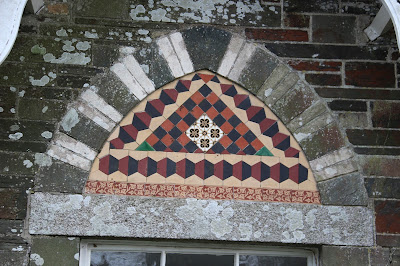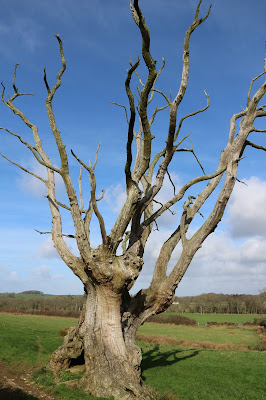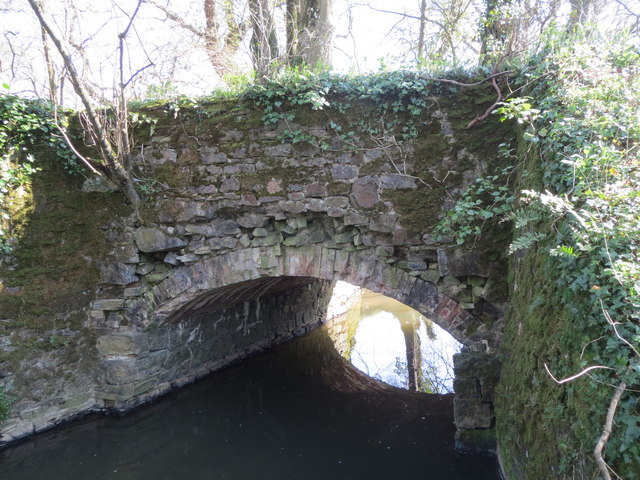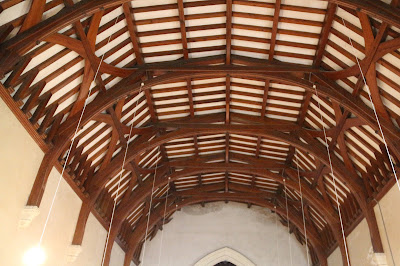The weather outside may be lousy but I can escape to warmer climes through the paintings of Paul Gaugin. I'd never put him at the top of my list of favourite artists but he's well up there. There's a lot more to him that topless ladies in the South Seas. And the music is rather tasty as well.
Quid me anxius sum? (Alfred E Neuman, Mad Magazine circa 1956). Facio, ita.
Tuesday 28 February 2017
Sunday 26 February 2017
A walk from Werrington Church
More new territory covered in this walk, with us venturing a few miles north of Launceston. A dry with sunny periods sort of day but, as we were in the aftermath of Storm Doris, the wind was quite strong in unsheltered parts.
 |
| Our starting point was Werrington Church and our just-under-five mile route took in fields and lanes in two river valleys, those of the Tamar and one of its tributaries, Tala Water. |
 |
| A tiled panel on the wall of the lodge to Werrington Park. I don't think it signifies anything other than being attractively decorative. |
 |
| A plaque that piqued our interest. Keynotes Education? Turns out that it was, quite simply, the business address of an educational supplies firm. But what a nice place to work. |
 |
| A Silver Birch growing out of a dead Hazel stump. It's interesting what the drive for survival produces. |
 |
| I just can't walk past an old oak tree without wanting to tie a yellow ribbon around it. |
 |
| After a little scrambling from the road, I managed to get this shot of part of the Bude Canal as it was taken over Tala Water in an aquaduct. The canal was built in the 1820s to carry sea sand and lime inland for use as fertiliser and the original canal system spanned 35 miles reaching just outside of Launceston. The canal closed in 1901 when competition from the railway, bringing cheap manufactured fertilisers, made it uneconomical. Today, roughly 2 miles of canal remain filled with water and make a very nice waterside walk from the centre of Bude. At this part of its route, it is reduced to a barely discernible indentation. |
 |
| St Martin of Tours taking a tour around the outside of the church? |
 |
| A lofty but rather bare interior. There are, however, some very interesting stained glass windows but the photographs I took didn't come out well. |
 |
| A fairly typical but rather featureless Victorian barrel ceiling. Nice carpentry but a few carvings would make it more interesting. |
Monday 20 February 2017
The Goodameavy Trek
A rather longer than expected walk with our monthly group this week. The promised "around 6 miles" turned out to be 9 1/2 and 9 1/2 tough ones at that. Lots of ups and downs, with the emphasis very much on the ups. But, with good weather and some new parts on the western edge of Dartmoor to discover, what was there to complain about? Apart from the ups, that is.
 |
| River Plym looking relatively benign. There hadn't been that much heavy rain in the preceding few days. |
 |
| I liked these tree roots wrapped around a large boulder. I think it was originally from an old hedge. |
 |
| Spring flower 1: Lesser Celandine. Not that many around but a good sign that the season is changing. |
 |
| Spring flower 2: Snowdrops. A sight to gladden every galanthophile's heart. Lots and lots of these around. |
 |
| Leighbeer Tunnel - a moment captured when cyclists weren't flying through. Question: why don't they use bells to warn walkers to get out of their way? Or do they prefer to knock people over? |
 |
| Oh look, we said, these look like miners' cottages. And indeed they were. Their age attesting to the long history of mining in this area. |
Friday 17 February 2017
If the Narcisstic Personality Disorder cap fits...

Since the rise of Donald Trump, the term “narcissistic” has been cropping up with boring regularity. As for most people, I have a superficial understanding of what it means, so it was interesting to read in this week's edition of the New Statesman, a piece by Dr Phil Whittaker, the resident medic. In this he looks at what he describes as 'the troubling psychological health problem of narcissistic personality disorder (NPD)'. People with NPD, he writes, have (the following) characteristic set of personality traits.
First, they have a deeply held sense of specialness and entitlement. Male NPD sufferers frequently present as highly egotistical, with an unshakeable sense of their superiority and importance. The affected person believes he is deserving of privileged treatment and expects it as a right from those around them.
Second, NPD sufferers have little or no capacity for empathy, and usually relate to other people as objects (as opposed to thinking, feeling beings) whose sole function is to meet the narcissist’s need for special treatment and admiration – known as “supply”. In order to recruit supply, NPD sufferers become highly skilled at manipulating people’s perceptions of them, acting out what is called a “false self” – the glittering high achiever, the indefatigable do-gooder, the pitiable victim. When surrounded by supply, the NPD sufferer relishes the waves of positive regard washing over them. Equally, when another person destabilises that supply (by criticising or questioning the narcissist’s false self) this is highly threatening, and the NPD sufferer will go to practically any lengths to prevent a destabiliser adversely influencing other people’s perceptions of the narcissist.
One of the many troublesome aspects of NPD is the invariable lack of insight. A narcissist’s experience of the world is essentially: “I am special; some people love me for this, and are Good; some people hate me for it, and are Bad.” Not uncommonly, health professionals end up helping those who have had the misfortune to enter into a supply relationship with an NPD sufferer. Narcissism is one of the most frequent factors in intimate partner and child abuse, as well as workplace bullying. The narcissist depends on the positive affirmation of others. They use others to shore themselves up and lash out at those who threaten this precarious balance. And they leave a trail of damaged people in their wake.
And having read what Phil Whittaker had to say, I watched some of the rather bizarre press conference DJT gave yesterday through this prism. Try it yourself and listen carefully to the language he uses. It fits. It's certainly not for me to make any medical diagnosis but...omg! It occurs to me that many governments around the world are employing psychologists to analyse each and every performance by DJT. "Tell us", the leaders ask, "how do we deal with a person with these personality traits?". Perhaps Mother Theresa had already had this advice when she scuttled off to the White House last month? Perhaps she had been told that the very best way to get on the good side of a narcissist is to massage the ego? And what better way to do this than with the extravagant pomp and circumstance of a full blown State Visit? Perhaps we've all underestimated her: not arse licking or brown nosing, just plain psychology. Nice one, Mother T.
Monday 13 February 2017
Public Enemy #2356
All the talk about the imposition of a blanket ban on some groups seeking entry into the USA brings to mind some experiences I had with the US Immigration Service a few years back.
I had been travelling to the US for the better part of a decade on a visa, which gave me multiple entries for business purposes for an indefinite period. My entry points varied and I became very familiar with airports at Boston, JFK, Philadelphia, Atlanta and Charlotte. I must have passed through US Immigration dozens of times without any problems. That is, until, beguiled by Richard Branson's Virgin's promises, I took a flight into Newark, New Jersey for an onward connection to Raleigh Durham in North Carolina. My entry went along these lines.
* I walk up to Immigration counter with the expectation of the usual off-hand stamping of my passport (what charm school did they use for the officials?) and then through to baggage reclaim.
* Immigration officer types my details into his computer, does a double take and then calls his supervisor over. They go into a huddle for a while and then I'm asked to step out of line and follow the supervisor.
* I'm taken to a windowless office/cubicle and, with no explanation given, told to wait.
* After what seemed ages, two men in suits came in and starting asking me questions about who I was, what my background was and where I was going. They could not or would not tell me why they were asking the questions, just that some 'irregularities' had been noticed.
* At this point I was quite sanguine and was confident that it would all be sorted out quickly. A minor bureaucratic glitch, that's all.
* They left the room and, again after a long wait, two different men in different suits came in and asked me exactly the same questions as the first two. Again no explanation was given and, when I raised the question of my fast approaching connecting flight, I was told that I would be with them until the 'irregularities' has been solved and, anyway, my suitcase had already been taken off the 'plane. They left the room.
* At this point I remember beginning to feel decidedly uneasy and the thought of being refused entry crossed my mind.
* After another long wait, yet another pair of besuited gentlemen came in and, guess what, asked me the same questions. Again no explanations but they did say that they needed to check a few details with 'someone' before they had finished with me. They left the room.
* At this point deportation seemed to be a real option facing me and I was wondering how I was going to explain that to the company I was working for.
* Then a single officer, with something approaching empathy, came in and took me through where things stood. They were not happy with some entries about me on their system, but couldn't tell me what the issues were. If I could get someone in authority in my company to vouch for me, they would let me enter 'this once' and I'd have to report to the US Embassy in London as soon as I got back to the UK after my visit. I only had one US contact number with me (this was before the days of mobile phones) and was allowed to give him a call. He took the message and said he'd speak with someone higher up in the organisation and get back as soon as he could. This happened pretty quickly and, after a conversation between Immigration and the company representative, I was allowed through.
* As luck would have it, getting another flight to Raleigh Durham was straightforward and I got there some ten hours after I should have, tired but relieved.
* My US hosts were gracious and apologetic for the 'Newark Incident' but, as I could tell them nothing of the reasons why I was questioned, we moved on with whatever I was over there for. I can't remember it ever being mentioned again.
Back in the UK I dutifully went to the US Embassy in Grosvenor Square to see if I could sort things out. Eventually I was granted an interview with a consulate official who was not that helpful and cancelled my visa with a hint of satisfaction. Same charm school as the immigration people? The 'without prejudice' reference on the stamp meant that whatever the issue underlying the problem, if it were resolved, I could still gain entry to the USA if I applied.
For the next few years, every time I needed to travel to the US I had to go to the Embassy to be interviewed personally and get formal permission. It was inconvenient but not a disaster. Eventually, after around 3 years, I found out, by sneaking a glance at a computer screen when I shouldn't have, that the root of my problems lay with some student political activities I engaged in during my undergraduate time (1966 to 1969) in Aberystwyth University. Yes, I was involved in a number of leftish groups but, good grief, this was Aberystwyth not Oxford or Cambridge. The downfall of the Western World was certainly not going to start in Aberystwyth but, having said that, I've always thought that our sit-in protest at the Post Office hastened the end of the Vietnam War. So, maybe, I shouldn't underestimate the threat we were perceived as posing. Notwithstanding this fantasy, no-one could or would explain to me why it took 20 years, from 1969 until 1987, for my murky past to catch up with me. And then, out of the blue, after almost three years, someone somewhere decided that I was not a potential enemy of the state and I got my multiple entry visa back. And after that, absolutely no problems with getting into the USA.
And does the above give me any special insight into the way that immigrants might be treated by the Trump regime? I'd be fooling myself if I thought that.
* I walk up to Immigration counter with the expectation of the usual off-hand stamping of my passport (what charm school did they use for the officials?) and then through to baggage reclaim.
* Immigration officer types my details into his computer, does a double take and then calls his supervisor over. They go into a huddle for a while and then I'm asked to step out of line and follow the supervisor.
* I'm taken to a windowless office/cubicle and, with no explanation given, told to wait.
* After what seemed ages, two men in suits came in and starting asking me questions about who I was, what my background was and where I was going. They could not or would not tell me why they were asking the questions, just that some 'irregularities' had been noticed.
* At this point I was quite sanguine and was confident that it would all be sorted out quickly. A minor bureaucratic glitch, that's all.
* They left the room and, again after a long wait, two different men in different suits came in and asked me exactly the same questions as the first two. Again no explanation was given and, when I raised the question of my fast approaching connecting flight, I was told that I would be with them until the 'irregularities' has been solved and, anyway, my suitcase had already been taken off the 'plane. They left the room.
* At this point I remember beginning to feel decidedly uneasy and the thought of being refused entry crossed my mind.
* After another long wait, yet another pair of besuited gentlemen came in and, guess what, asked me the same questions. Again no explanations but they did say that they needed to check a few details with 'someone' before they had finished with me. They left the room.
* At this point deportation seemed to be a real option facing me and I was wondering how I was going to explain that to the company I was working for.
* Then a single officer, with something approaching empathy, came in and took me through where things stood. They were not happy with some entries about me on their system, but couldn't tell me what the issues were. If I could get someone in authority in my company to vouch for me, they would let me enter 'this once' and I'd have to report to the US Embassy in London as soon as I got back to the UK after my visit. I only had one US contact number with me (this was before the days of mobile phones) and was allowed to give him a call. He took the message and said he'd speak with someone higher up in the organisation and get back as soon as he could. This happened pretty quickly and, after a conversation between Immigration and the company representative, I was allowed through.
* As luck would have it, getting another flight to Raleigh Durham was straightforward and I got there some ten hours after I should have, tired but relieved.
* My US hosts were gracious and apologetic for the 'Newark Incident' but, as I could tell them nothing of the reasons why I was questioned, we moved on with whatever I was over there for. I can't remember it ever being mentioned again.
Back in the UK I dutifully went to the US Embassy in Grosvenor Square to see if I could sort things out. Eventually I was granted an interview with a consulate official who was not that helpful and cancelled my visa with a hint of satisfaction. Same charm school as the immigration people? The 'without prejudice' reference on the stamp meant that whatever the issue underlying the problem, if it were resolved, I could still gain entry to the USA if I applied.
For the next few years, every time I needed to travel to the US I had to go to the Embassy to be interviewed personally and get formal permission. It was inconvenient but not a disaster. Eventually, after around 3 years, I found out, by sneaking a glance at a computer screen when I shouldn't have, that the root of my problems lay with some student political activities I engaged in during my undergraduate time (1966 to 1969) in Aberystwyth University. Yes, I was involved in a number of leftish groups but, good grief, this was Aberystwyth not Oxford or Cambridge. The downfall of the Western World was certainly not going to start in Aberystwyth but, having said that, I've always thought that our sit-in protest at the Post Office hastened the end of the Vietnam War. So, maybe, I shouldn't underestimate the threat we were perceived as posing. Notwithstanding this fantasy, no-one could or would explain to me why it took 20 years, from 1969 until 1987, for my murky past to catch up with me. And then, out of the blue, after almost three years, someone somewhere decided that I was not a potential enemy of the state and I got my multiple entry visa back. And after that, absolutely no problems with getting into the USA.
There are a few things about this whole affair that have always puzzled me: who collected and passed on the information about me from Aberystwyth? And how was the connection made between D Parsons Student in Aberystwyth and D Parsons Scientist in Kent? Was this information gathered by the US or passed to them by the UK? Maybe I ought to try a Freedom of Information request to find out. Maybe one day I will.And does the above give me any special insight into the way that immigrants might be treated by the Trump regime? I'd be fooling myself if I thought that.
Friday 10 February 2017
A walk from St Cleer
A clear, bright but cold day for a walk starting and ending in St Cleer, a large village about 10 miles from home. Guess what? It was dry. Who says it rains incessantly in Cornwall?
 |
| Just under 5 miles and a mixture of tracks, footpaths, fields and quiet country lanes. Nothing too challenging but a great day to be out and about. |
 |
| I just liked the contrasting colours of nature on this tree stump. Moss, fungi and lichens all blending together. |
 |
| Clear skies and far reaching views aplenty on this walk. Here we are looking west towards St Austell. But the sun belies the sub-freezing temperatures when the wind got up. |
 |
| My first lambs of the Spring. A good sign that Winter is coming to an end - possibly. |
 |
| An interesting stretch of the walk when we laboured uphill along the bed of a stream cum footpath. |
 |
| But it was worth it when we came to drier parts and were able to walk under a canopy of branches. It's an old track leading from one mine to another. |
 |
| The cover of the well with its statue of St Clarus (looking rather haunted as if hiding from his admirer) and the corner pinnacles echoing the design of the church tower. |
 |
| Another sign of Spring, Crocuses in the graveyard back at the start. |
Subscribe to:
Posts (Atom)

























